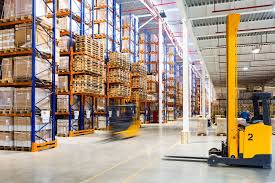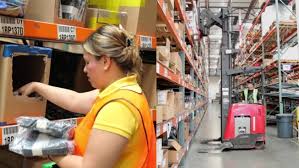What is pick and pack fulfillment?
In a warehouse, pick and pack fulfillment is the process that occurs after an order is placed from an online store. Picking is using a picking list to find of the proper quantities of each product from its respective location in the warehouse. Packing is the placing of the items into the proper box, along with the appropriate packing materials and documentation before the package is labelled and shipped to the end customer.
Pick and pack fulfillment must be streamlined to reduce the cost of ecommerce fulfillment. For picking, this means reducing the labor required to choose the right products for an order. Warehouses that do pick and pack fulfillment have a few different ways to do this: piece picking, batch picking, zone picking, and wave picking.
- Piece picking is when an employee handpicks each product for an entire order, as they come in.
- Batch picking is similar to piece picking, except that orders will be done in batches all at once, instead of one at a time.
- Zone picking is when employees are assigned to a specific area of the warehouse and only pick one order at a time within that area. If an order needs products from more than one zone, it is handed off usually via conveyor belt.
- Wave picking is a combination of batch and zone picking, where employees will stay within a zone but pick more than one order at a time.
Packing involves placing the items into the appropriate sized box with the right packaging materials to ensure they reach their final destination undamaged. To reduce shipping costs, packing should keep an order within the smallest number of boxes and use the right type of packing material(s) for each product. Many warehouses will have a warehouse management system that can help detail which box will be the most appropriate choice for the order at hand.

Choosing an Order Fulfillment Service
As a business grows, the owner, employees and devoted helpers often spend a great deal of time doing the following:
- Organizing inventory
- Receiving shipments
- Repacking products to send to customers
Time spent devoted to on-site inventory is time away from marketing and sales efforts. It also places a glaring spotlight on a positive business problem: the need to outsource certain business tasks like fulfillment.
Business owners who work outside the home probably don’t have products piled everywhere in their homes. However, they have other reasons to seek off-site inventory:
- They need freedom from managing unorganized and inaccurate inventory.
- They want to streamline the fulfillment process by improving logistics and web-based ordering abilities.
- They want to focus more on sales than warehouse and fulfillment.
- They’re interested in direct marketing campaign, but lack space to get the task done.
- They want to save overhead and employee costs.

What Are Pick and Pack Methods?
When you begin to pick, pack, and ship your products, you start with methods you use in your life. You might organize your inventory the way you organize your closet. That is, put all the pants together and all the shirts together, organized by color. You might also pack your orders the way you would assemble a package to send to a friend. That is, gather the items for each order and pack them one at a time.
At first, this may work for your eCommerce business. As your business grows, however, you will need to adopt different strategies. Even if you work out of your garage, better pick and pack methods can reduce mistakes and returns. You’ll save money and your customers will be happier.
pick and pack methods
The pick and pack methods that work well for your business will depend on your size and your products. You might change the way you pick, pack, and ship as your business grows. Here are some basic pick and pack methods that many eCommerce companies use for fulfillment.

Overlooked Tips for Finding the Right eCommerce Fulfillment Center
Order fulfillment is a critical component to your overall business operations. If you are experiencing signs that reveal your current eCommerce fulfillment company is failing to deliver, it’s time to get smart about your eCommerce fulfillment center. However, any changes to your current processes should not be taken lightly. We’ve gathered some often overlooked tips to help you find the best fulfillment center. Follow the following tips to ensure your new eCommerce fulfillment center exceed your customers’ expectations.
1.Define Your Short-term and Long-term eCommerce Goals
Evaluating your current eCommerce fulfillment center will help identify areas of improvement that can be accomplished in the short-term and the long-run. Short-term goals for your operations may include:
- Cutting down on shipping times and shipping costs
- Improving order accuracy and reducing returns
- Decreasing customer support response times
Long-term goals for your business may include:
- Lessening the strain on internal departments (accounting, customer service, and operations)
- Expanding fulfillment operations into multiple facilities (ex. east coast and west coast)
- Expanding product line to allow for additional SKUs and inventory
Discuss these items with your potential order fulfillment center to determine the timelines for implementing solutions that will best support your goals and continued business growth. Whether you’re looking for a West coast fulfillment center or East coast location
2. Evaluate the Fulfillment Provider’s Expertise within Your Market Niche
Although eCommerce retailers often get lumped into one group, there is a huge amount of diversity in the types of products sold over the internet and their fulfillment needs, and finding the best fulfillment centers for your industry is key. Ask your potential eCommerce fulfillment center about the industry verticals they pick, pack and ship. If you have a specialized product or need customized fulfillment processes, look for providers with similar clients. Many eCommerce fulfillment centers are specialized with robotics and equipment designed to handle specific types of products. Asking the right questions will help you identify both strengths and weaknesses. For example, Warehouse A works closely with clothing retailers, Warehouse B works closely with large, heavy goods, and Warehouse C works mostly with small electronics. Each of these eCommerce fulfillment centers will be likely to have greater know-how on special handling of their serviced market verticals. Each warehouse will be better equipped to store the different types of products. For example, hanging storage for clothing, ample storage for large goods, or secured storage for high-value electronics. In addition, the employees will have experience with handling and packaging your products with greater efficiency than an inexperienced firm.
3. Select a Fulfillment Provider that Aligns with Your Vision & Values
The mission of a company will often provide clues regarding the future success of your business partnership. When choosing a fulfillment center, focus on creating a long-term partnership that will benefit both parties. Look to partner with an order fulfillment company that has a business model built around principles such as continuous advancement, professionalism, and maximizing customer satisfaction reassures your best interests will be looked out for.
4. Assess the Level of Flexibility and Personalization Available
This is important, especially for growing businesses whose business model evolves over time. Determine the extent to which accommodations can be made as your business evolves and your order fulfillment needs change. Not all online fulfillment centers are capable of accommodating changing needs on short notices, something which is crucial for growing businesses. Large-scale facilities with streamlined operations and abundant resources can better handle stressful situations that will help your growing business succeed.
5. Confirm the Provider’s Levels of Customer Support and Communication
Your first interactions with a provider will give you a glimpse as to what it will be like working with them further down the road. During your inquiry or quote, keep the following questions in mind:
- How quickly did you receive a response?
- How knowledgeable was the representative in answering your questions?
- Did the fulfillment provider take the time to get to know your business?
What are the Types of Pick and Pack Processes?
There are a few distinct types of pick and pack processes. Here are 4 of them.
Discrete Order Picking
Discrete order picking is the process preferred most by small businesses.
Here’s an example of how it works:
You receive 2 orders
You pick and pack all the items for the first order
Then you proceed to pick and pack all the items for the second order
Rinse and repeat
You only ever complete the pick and pack process for one order at a time.
It’s used by small businesses very often because they usually have smaller product catalogs and order volumes and want to reduce mistakes as much as possible.
Batch Picking
Instead of fulfilling one order at a time, batch picking is a process of gathering one batch of SKUs at a time.
For example:
If you have 5 orders, and 3 of them require Widget A, while 2 of them require Widget B, you would pick all the Widget As first, then pick the Widget Bs. This helps save time and fulfill more orders quickly – making it ideal for SMB’s with larger product and order volumes.
Wave Picking
Wave picking is a process that blends discrete and batch picking together.
Groups of similar orders are fulfilled during scheduled time frames, or waves.
The orders may have similar SKUs, similar shipping deadlines, or could simply be in close proximity to one another.
Zone Picking
Zone picking consists of different employees assigned to different zones within your warehouse and only picking items located in their specific zone.
For example:
If an order comes through that requires items from Zone A and Zone B, the picker in Zone A will gather his items and pass on the order to the picker in zone B to complete the order.
This is ideal for large businesses with a high rate of inventory turnover.